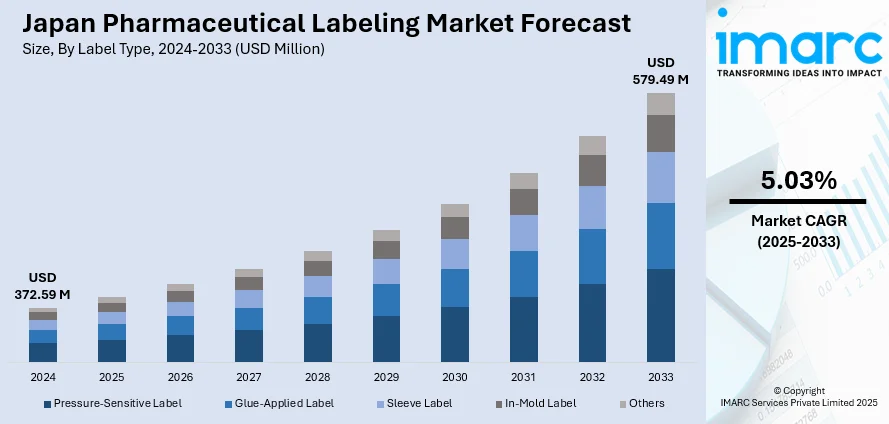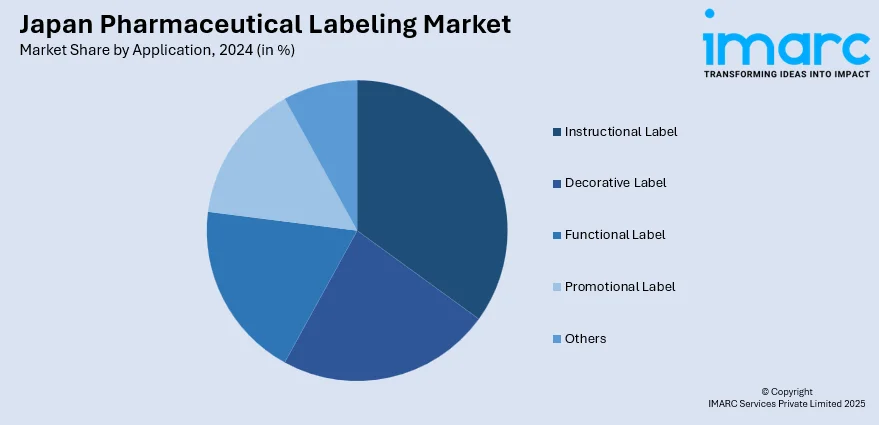
Japan Pharmaceutical Labeling Market Size, Share, Trends and Forecast by Label Type, Material, Application, End Use, and Region, 2025-2033
Japan Pharmaceutical Labeling Market Overview:
The Japan pharmaceutical labeling market size reached USD 372.59 Million in 2024. Looking forward, IMARC Group expects the market to reach USD 579.49 Million by 2033, exhibiting a growth rate (CAGR) of 5.03% during 2025-2033. The increasing regulatory compliance requirements, rising demand for traceability and anti-counterfeit solutions, advancements in digital labeling technologies, the expanding pharmaceutical sector, and the escalating need for improved patient safety, product information accuracy, and enhanced supply chain efficiency are among the key factors driving the market growth.
|
Report Attribute
|
Key Statistics
|
|---|---|
|
Base Year
|
2024 |
|
Forecast Years
|
2025-2033
|
|
Historical Years
|
2019-2024
|
| Market Size in 2024 | USD 372.59 Million |
| Market Forecast in 2033 | USD 579.49 Million |
| Market Growth Rate 2025-2033 | 5.03% |
Japan Pharmaceutical Labeling Market Trends:
Digitalization and Automation in Labeling Processes
Digital transformation is revolutionizing pharmaceutical labeling with the integration of digital printing, IoT-enabled devices, and automated workflows. Manufacturers are increasingly investing in advanced digital labeling systems that not only streamline production but also enhance traceability and reduce human errors. According to a 2024 survey by the Japan Pharmaceutical Manufacturers Association, digital labeling technologies are projected to see a 42% adoption increase between 2023 and 2025. This shift is significantly reducing labeling mistakes, with error rates dropping by 25% following automation, as reported by industry research in early 2024. These innovations enable real-time data capture and monitoring, ensuring compliance with evolving regulatory standards and offering considerable cost savings. Digital labeling also facilitates dynamic content updates, keeping critical product information such as batch details and expiration dates accurate, which is especially crucial as demand for personalized, patient-specific information rises. The integration of AI-driven analytics further optimizes labeling processes, proactively identifying potential issues. Market analysts predict that these technological advancements will improve overall productivity by up to 30% over the next two years, marking a continued shift toward more efficient, reliable pharmaceutical labeling systems.

Enhanced Regulatory Compliance and Security Measures
In response to stringent regulatory requirements and the increasing threat of counterfeiting, pharmaceutical companies in Japan are significantly enhancing their labeling strategies. An increasing number of manufacturers are integrating security features such as holograms, QR codes, and blockchain-enabled traceability. These advancements are driven by the revised Pharmaceutical Affairs Act, which has led to a considerable rise in investments in high-security labels. These measures are critical for ensuring product authenticity and safeguarding patient safety, addressing growing concerns over counterfeit drugs entering the supply chain. Additionally, smart labels have proven to reduce recall times, enabling swift verification of product details during distribution. By adopting globally harmonized standards, Japan's pharmaceutical sector is not only strengthening its domestic market but also improving its global competitiveness. The integration of secure digital certificates and advanced tracking solutions ensures compliance with both local and international regulations, further enhancing the reliability of the industry.
Japan Pharmaceutical Labeling Market Segmentation:
IMARC Group provides an analysis of the key trends in each segment of the market, along with forecasts at the region/country level for 2025-2033. Our report has categorized the market based on label type, material, application, and end use.
Label Type Insights:
- Pressure-Sensitive Label
- Glue-Applied Label
- Sleeve Label
- In-Mold Label
- Others
The report has provided a detailed breakup and analysis of the market based on the label type. This includes pressure-sensitive label, glue-applied label, sleeve label, in-mold label, and others.
Material Insights:
- Paper
- Polymer Film
- Others
A detailed breakup and analysis of the market based on the material have also been provided in the report. This includes paper, polymer film, and others.
Application Insights:

- Instructional Label
- Decorative Label
- Functional Label
- Promotional Label
- Others
The report has provided a detailed breakup and analysis of the market based on the application. This includes instructional label, decorative label, functional label, promotional label, and others.
End Use Insights:
- Bottles
- Blister Packs
- Parenteral Containers
- Pre-Fillable Syringes
- Pre-Fillable Inhalers
- Pouches
- Others
A detailed breakup and analysis of the market based on the end use have also been provided in the report. This includes bottles, blister packs, parenteral containers, pre-fillable syringes, pre-fillable inhalers, pouches, and others.
Regional Insights:
- Kanto Region
- Kansai/Kinki Region
- Central/Chubu Region
- Kyushu-Okinawa Region
- Tohoku Region
- Chugoku Region
- Hokkaido Region
- Shikoku Region
The report has also provided a comprehensive analysis of all the major regional markets, which include Kanto Region, Kansai/Kinki Region, Central/Chubu Region, Kyushu-Okinawa Region, Tohoku Region, Chugoku Region, Hokkaido Region, and Shikoku Region.
Competitive Landscape:
The market research report has also provided a comprehensive analysis of the competitive landscape. Competitive analysis such as market structure, key player positioning, top winning strategies, competitive dashboard, and company evaluation quadrant has been covered in the report. Also, detailed profiles of all major companies have been provided.
Japan Pharmaceutical Labeling Market News:
- February 2025: Bain Capital agreed to acquire Mitsubishi Tanabe Pharma Corporation (MTPC) from Mitsubishi Chemical Group for approximately JPY 510 billion (USD 3.3 billion) in a carve-out transaction. Bain reportedly planned to capitalize on the deal to enhance R&D and global expansion, including modernizing pharmaceutical labeling processes to meet diverse regulatory requirements, improve supply chain traceability, and support international market entry.
- April 2024: Ono Pharmaceutical Co., Ltd. entered into a definitive agreement to acquire Deciphera Pharmaceuticals, Inc. for approximately USD 2.4 billion. This strategic move supported Ono’s ambition to strengthen product development and commercialization pipelines. It also presented opportunities for integrating Deciphera’s labeling systems with Ono’s, ensuring compliance across regulatory jurisdictions.
Japan Pharmaceutical Labeling Market Report Coverage:
| Report Features | Details |
|---|---|
| Base Year of the Analysis | 2024 |
| Historical Period | 2019-2024 |
| Forecast Period | 2025-2033 |
| Units | Million USD |
| Scope of the Report | Exploration of Historical Trends and Market Outlook, Industry Catalysts and Challenges, Segment-Wise Historical and Future Market Assessment:
|
| Label Types Covered | Pressure-Sensitive Label, Glue-Applied Label, Sleeve Label, In-Mold Label, Others |
| Materials Covered | Paper, Polymer Film, Others |
| Applications Covered | Instructional Label, Decorative Label, Functional Label, Promotional Label, Others |
| End Uses Covered | Bottles, Blister Packs, Parenteral Containers, Pre-Fillable Syringes, Pre-Fillable Inhalers, Pouches, Others |
| Regions Covered | Kanto Region, Kansai/Kinki Region, Central/Chubu Region, Kyushu-Okinawa Region, Tohoku Region, Chugoku Region, Hokkaido Region, Shikoku Region |
| Customization Scope | 10% Free Customization |
| Post-Sale Analyst Support | 10-12 Weeks |
| Delivery Format | PDF and Excel through Email (We can also provide the editable version of the report in PPT/Word format on special request) |
Key Questions Answered in This Report:
- How has the Japan pharmaceutical labeling market performed so far and how will it perform in the coming years?
- What is the breakup of the Japan pharmaceutical labeling market on the basis of label type?
- What is the breakup of the Japan pharmaceutical labeling market on the basis of material?
- What is the breakup of the Japan pharmaceutical labeling market on the basis of application?
- What is the breakup of the Japan pharmaceutical labeling market on the basis of end use?
- What are the various stages in the value chain of the Japan pharmaceutical labeling market?
- What are the key driving factors and challenges in the Japan pharmaceutical labeling market?
- What is the structure of the Japan pharmaceutical labeling market and who are the key players?
- What is the degree of competition in the Japan pharmaceutical labeling market?
Key Benefits for Stakeholders:
- IMARC’s industry report offers a comprehensive quantitative analysis of various market segments, historical and current market trends, market forecasts, and dynamics of the Japan pharmaceutical labeling market from 2019-2033.
- The research report provides the latest information on the market drivers, challenges, and opportunities in the Japan pharmaceutical labeling market.
- Porter's five forces analysis assist stakeholders in assessing the impact of new entrants, competitive rivalry, supplier power, buyer power, and the threat of substitution. It helps stakeholders to analyze the level of competition within the Japan pharmaceutical labeling industry and its attractiveness.
- Competitive landscape allows stakeholders to understand their competitive environment and provides an insight into the current positions of key players in the market.
Need more help?
- Speak to our experienced analysts for insights on the current market scenarios.
- Include additional segments and countries to customize the report as per your requirement.
- Gain an unparalleled competitive advantage in your domain by understanding how to utilize the report and positively impacting your operations and revenue.
- For further assistance, please connect with our analysts.
 Request Customization
Request Customization
 Speak to an Analyst
Speak to an Analyst
 Request Brochure
Request Brochure
 Inquire Before Buying
Inquire Before Buying




.webp)




.webp)












